| « James Fritz Headlining Queer Comedy At Zanies | Intimate Apparel at Theatre School at DePaul » |
Art Mon Sep 19 2011
Glass Curtain's CoLaboratory Puts the Art in Your Hands
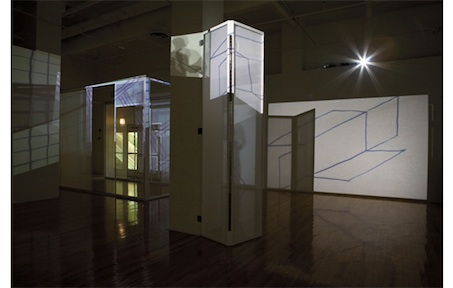
Columbia College's Glass Curtain Gallery has taken interactive art to another level with their current exhibition, CoLaboratory. Two artist collaboratives - ED JR. and (f)utility projects have joined forces to create a site specific video installation with moveable screens that, although quite beautiful in its own right, is made manifest by you - the visitor. Visitors are invited to adjust the structures on which video projections are shown, amending and re-forming the evolving images as they move. If that's not enough interaction for you, check out one of ED JR.'s free, public workshops at the gallery (Thursday, September 22, 6-8pm; Saturday October 1, 3-5pm; Thursday October 27, 6-8pm), where you can get your hands dirty and be featured in a video, which will be later projected in the space.
"It was very brave of Columbia to tell us to go ahead and do it without having any idea what was going to be in here," said the exhibition's curator, Annie Morse. "When they approved the proposal, it was very vague -- it said, 'it's going to have this aspect, and we hope to create these experiences, but we can't tell you what it's going to look like.'"
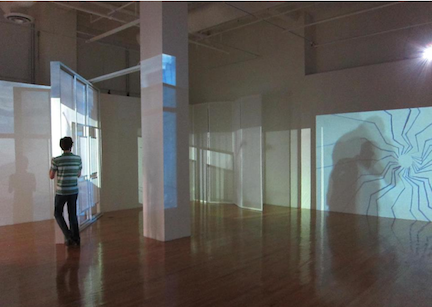
"We consider ourselves a site-specific collaborative," adds Chris Grieshaber of (f)utlity projects. "As we were watching the videos by ED JR., we realized there were so many perceptual possibilities inherent, that we saw our role as acting as a bridge in a way between the videos and the actual space of the gallery. It was a very organic process, we had no idea what we were doing when we started. So we spent a lot of time in the gallery to steep in it like tea."
"We were working up until the last minute, figuring out how to project things, getting the lighting right," adds Edra Soto, a member of ED JR. "And we had a lot of obstacles -- all the projectors are very different. There was a lot of playing involved. We were working on project-by-project basis before, but for this exhibition we were thinking more about very simple changes in relation to the space and trying to have this connection with (f)utility. And it lead us to all these different references, and it became something of its own. It was really fun to work together. That's the main reason I joined a collaborative group of artists in the first place -- to have fun. I wouldn't do it for any other reason. When you're having fun, things happen because there is excitement."
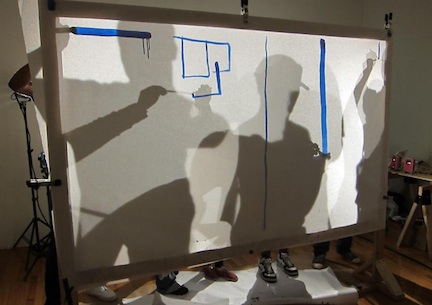
"The great thing about this show to me," (muses Morse) "is that these are the material traces of making the work but actually the show is a combination of the process of making and what visitors bring to it. Because it's really not finished. This [the installation] is splendid, but what is really interesting for the artists and for me is the way the shadows of the visitors interact with the installation, and the way that shifts things and changes things. I hope that people come in and take photos of that and post them on the internet so that the installation has a longer digital life."
Morse adds: "The closing reception is in some ways more important because it is the culmination of the whole show. There's a kind of hands on, hands off property that ED JR. experienced [during the first workshop] where they came into the process with some strict rules and those rules went right out the window pretty quickly because people were so delighted to be painting that they couldn't stop and follow the rules. In fact, the ED JR. people had kind of a contact high from being around people who don't usually paint but were really enjoying that collaborative process."
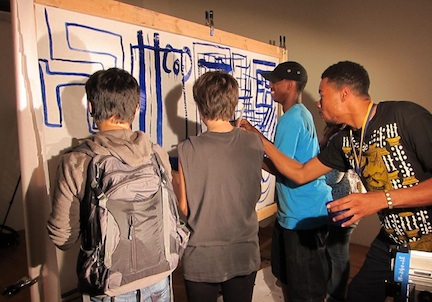
"We've been trying through this process to continue the collaborative process of viewing the work and interacting with the work both personally and as a group," adds Grieshaber. "It's not necessarily the leading intention behind one artist that makes the work interesting or good, it's the fact that somebody came in, was able to look at it and be effected some way and have that influence the way they go about the universe."
Morse: "One of the things that's frustrating as a curator about working at an art museum is that people tend to look at the museum as a box full of stuff and it isn't, it's a matrix through which experiences are available to you."
"I love that our names are not on the wall," adds Soto. "This is seven artists' work but it doesn't matter who they are. We can enjoy looking at it and having that ownership, but as I talk about it I feel like I didn't do it. So I can say it's beautiful and special, probably the most special project I've been involved with because the artists' ego is removed."
"It's a show for the people who come see it," adds Grieshaber, "it's not about us."
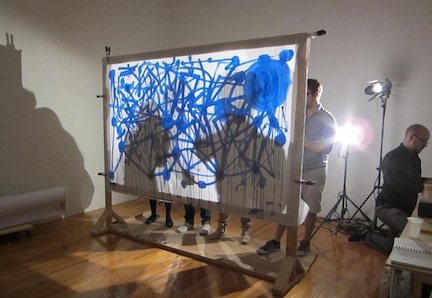
CoLaboratory will be up through November 2, with a lecture with ED JR. and (ƒ)utility projects collective members PaolaCabal and Edra Soto, Monday, September 26, and three more workshops in September and October. Details can be found at Columbia College's website.
*All photos by Edra Soto unless otherwise noted.








